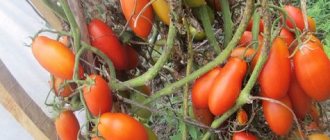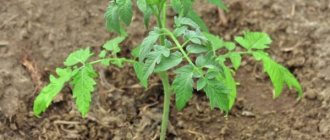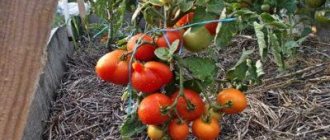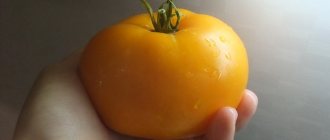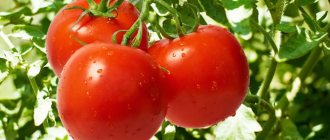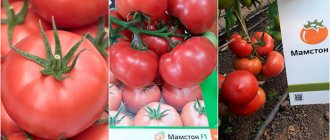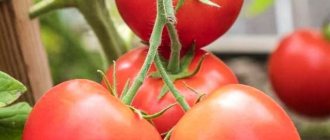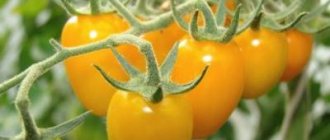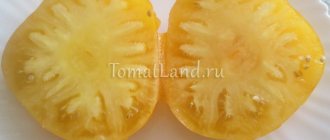» Vegetable growing » Tomatoes » Growing Niagara tomatoes
0
989
Article rating
The Niagara tomato is a plum variety. It is especially popular among amateur vegetable growers. Ideal for creating winter preparations. He was bred in Siberia. In 2010 it was included in the State Register. Cultivation in both open and protected ground is recommended.
- Growing seedlings
- Transplanting seedlings and care
- Reviews from gardeners
Growing Niagara Tomato
Tomato varieties for the greenhouse, Niagara variety: video
The Niagara variety is new to me, I have only grown it for one year, but I already have impressions.
I will try to honestly note the noted shortcomings and advantages. Flaws:
- out of 25 seeds in the package, only 15 sprouted, and sprouts appeared only at 4 weeks. At the same time, by this time the remaining varieties had already produced cotyledon leaves;
- seedlings with thin trunks, elongated, weaker than other varieties.
Advantages:
- from each bush I collected from 8 to 10 kg of fruits (from my old varieties - no more than 4-5 kg);
- the tomatoes are all smooth, with strong skin, ideal for pickling;
- the taste is good, practically no acid;
- mature gradually, managed to process it.
I think you already understand my conclusion - continue to plant this variety, just try to remove the noticed shortcomings.
I love experimenting in the garden. I saw a variety with an exotic name - Niagara, and decided to take it. I thought that this name was just an advertising feature.
But when I saw the 2-meter vines of these tomatoes, strewn from top to bottom with even tomatoes with a pimple at the tip, I realized that the name reflects the essence of the variety. I collected a bucket of tomatoes from each bush. I definitely recommend it.
My wife and I just started gardening, we have no experience yet. But I want my own tomatoes and cucumbers, I’m tired of eating plastic ones. Colleagues advised planting different varieties of tomatoes, from early to late. Some will definitely be born. We bought seedlings of the Niagara variety from the early ones, although we didn’t really like the seedlings: they were kind of flimsy.
But the saleswoman advised burying the seedlings up to the lower leaves and feeding them more often. And so they did. And the seedlings have recovered! Of all the planted varieties, Niagara turned out to be the most abundant - 8 kg were collected from each bush. Moreover, it turned out to be a very early variety: the others were still just blooming, but this one had already produced brown tomatoes.
True, they fed it once every 3 weeks, and mainly with ash, yeast water - in short, natural, without chemicals. There is no doubt left - we will continue to plant this variety!
Tomato Niagara indent is a plant of unlimited growth (150-200 cm). Throughout the growing season it forms shoots; their growth must be forcibly limited by breaking the growth points.
According to the ripening period, the variety belongs to the group of mid-ripening tomatoes. The fruiting period begins after 100 (115 days) of cultivation.
The bushes are compact, the roots are developed and powerful. Thanks to them, the bush during a short-term drought receives a sufficient amount of nutrients for the formation of fruits. The stems are thin and frail, but this does not affect the quantity and quality of the harvest.
On externally thin stems, full clusters with 10-15 fruits are formed. The manufacturer recommends growing a bush with 1-2 trunks, but in practice, many summer residents prefer a different formation scheme, leaving 3 to 4 stems.
One-dimensional cream weighing from 80 to 100 g is formed in the brush. Niagara tomato fruits are characterized by a small tip (spout) at the tip. When growing a bush with 1 trunk, you can get larger fruits weighing from 120 g.
The skin of tomatoes is red, thin, strong, not rough. The pulp is not dry, fleshy. There are three seed chambers. Seed size is average. The taste of the pulp has a classic sourness, the taste is harmonious. Cream is an excellent raw material for making sun-dried tomatoes. From the fruits of the Niagara tomato you can prepare pickles, marinades, ketchup and tomato paste. They also make juice from them, it turns out thick and tasty.
Varvara, Krasnodar region
Galina, Krasnoyarsk region
Albina, Vladimir
A self-respecting vegetable grower stocks up with reliable varieties of tomatoes in order to get a rich harvest of tasty fruits with minimal labor costs. The Niagara tomato is one of these varieties. This is a hybrid obtained by Russian breeders not so long ago, so few people know about it.
That is why we decided to devote an article to the Niagara variety, so that it takes its place in the beds and greenhouses of Russians. We will present to your attention the information at our disposal about the Niagara tomato with characteristics, description of the variety, photos and videos.
Now let’s take a closer look at the features of the variety:
- Tomatoes are indeterminate, which means that the main stem does not stop growing throughout the growing season. Tomatoes of this variety are tall; if there is space in the greenhouse, they grow taller than a person of average height.
- The root system is powerful, so the plant can withstand a slight drought, which is especially important for summer residents who do not have the opportunity to come to the site often. But the stem, compared to tall varieties, is thin. Gardeners note this feature in their reviews. In addition, they report that when growing Niagara tomatoes for the first time, they were afraid that they would not get the desired yield. But their fears were not justified. Despite its apparent fragility, the plant forms powerful flower clusters. The bush just needs to be tied up all summer.
- As a rule, a tomato is formed into one or two stems. Although you can experiment, like some of our readers. They left 4 stems and got a good result, but the fruits were not so large.
- Flower tassels appear through one internode; with good care, up to 10-12 tassels can be counted on the plant. Each of them bears up to 14 fruits. The brushes are long and strong. It is quite possible to judge the yield of the Niagara tomato based on reviews and photos (see below): it is excellent.
The fruits are oval-shaped, with a pipette. Many people call them cream. On the bunch, Niagara tomatoes are almost the same size, weighing 80-100 grams. A plant grown in one trunk can produce fruits of about 120 grams.
Tomatoes ripen, as a rule, on the vine, and the process does not occur simultaneously, which is why in a greenhouse or in the open ground there is a real rainbow of colors even of one variety. Look at the photo and see for yourself!
Tomatoes are three-chambered, medium-sized seeds. The skin is dense, but not tough. The fruits are good for canning; they never fall apart. The pulp is fleshy and sweet. You can feel the sourness, but it tastes good. Tomato paste and tomato juice are thick and tasty.
Medium-early (fruit ripening begins approximately on the 110th day from the moment of germination), very productive, cluster variety. Recommended for cultivation in greenhouses and in open ground with mandatory tying to a support.
The leaves of this tomato are medium-sized and green. The inflorescence is simple. It is best to form a plant into 3 stems. The bushes themselves are quite tall (1.6-1.8 meters), but at the same time not spreading, so you can plant up to 4 pieces per 1 square meter in the ground. meter. When forming into 1 stem, planting 6 plants per 1 square meter is allowed. meter of plot.
photo author Mira Tom
The fruits are elongated cream with a “spout”, collected in clusters of 6-10 pieces, at the ripe stage of rich red color, weighing 60-100 grams. The pulp is dense, not watery, with a good tomato taste. These tomatoes are ideal for pickling and canning; they are also suitable for fresh consumption. Their skin is dense (but not hard) and does not crack.
This variety is consistently productive in any summer, whether it’s too hot or too cool. Absolutely unpretentious.
Not prone, like many other creams, to developing blossom end rot. The advantages also include the good keeping quality of the fruit.
The only drawback of this variety is that the ripe fruits do not stick well to the bush and fall off almost when touched.
The Niagara tomato variety is included in the State Register of the Russian Federation for cultivation under film covers on private farms.
If you have grown Niagara tomatoes, please write how you liked this variety and why it disappointed you. Will you grow it again? Evaluate the disease resistance of these tomatoes. Briefly describe the advantages and disadvantages of this tomato in your opinion. If possible, attach a photo of the entire bush or individual fruits you grew to your comment. Thank you!
Your reviews of the Niagara tomato and additions to the description will help many gardeners evaluate this variety more objectively and decide whether it is worth planting or not.
Tomato
The market is saturated with tomato seeds of various varieties. But each of them, along with its advantages, also has its disadvantages, which turns the choice into a difficult task. And here a good compromise is the Niagara tomato.
The variety was bred in Siberia, which in itself deserves attention. The originator of Novosibirskaya initially announced the tomato for cultivation in greenhouses, but later, since 2010, it received registration in the State Register of the Russian Federation in open ground.
Is this variety really devoid of disadvantages?!
Description of fruits
In relation to Niagara, any compromise that we have already discussed can be called a golden mean. When we talk about tomatoes, we mean large-fruited giants and cherry cherries.
Size
Niagara is a plum-shaped variety with an average weight of one-dimensional fruits of 60-80 g. The fruits really look like very large plums with a sharp nose. The ratio of the length of tomatoes to their width is 3:1.
Such cream, even of the largest size, fits into the neck of the jar and is thus suitable for whole-fruit canning.
Taste
Their thick, bright red skin ensures long-term storage of the harvested crop and is not prone to cracking during heat treatment. In general, Niagara is a universal purpose variety.
The good taste of the fruits makes them attractive for fresh use, including in salads. This tomato is also well suited for making juices, pastes and ketchups.
Description of the plant
Niagara has an indeterminate bush, the height of which reaches 150-180 cm. The tassels on the plant are tied through one internode. In total, there can be 5-8 similar clusters on a bush and each has up to 10 fruits.
Bush formation
Fruiting of plants lasts for more than a month. Multi-colored lashes of fruits of different ripeness look like a cascade of waterfalls, which determined the name of the variety - Niagara.
Bushes are formed into 1, 2, 3 and even 4 stems. The higher this number, the smaller the size of the fruit, but this does not affect the overall yield, although, of course, it delays the onset of ripening. And here there is a choice: who likes what more. However, different bushes can be shaped in different ways.
Ripening time
The time from the first shoots to the first harvest ranges on average from 105 to 115 days, which makes it possible to classify Niagara as a mid-season variety. And this is also the golden mean. The more early the variety is, the lower its yield.
On the other hand, high-yielding hybrids with late ripening periods always run the risk of falling under the wave of late summer late blight, and then the entire harvest will be lost.
Advantages and disadvantages of the variety
And yet there is no variety that is completely free of shortcomings. Let's take a closer look at the properties of Niagara.
Advantages
- Like all Siberians, it is unpretentious and provides a stable harvest regardless of weather conditions.
- It resists viral and fungal diseases well.
- The fruiting period, extended to a month, allows you to process the entire harvest without undue haste and make the necessary preparations for the winter.
- To this we must add the good keeping quality of the fruit - tomatoes can be stored fresh for a long time. They also tolerate transportation painlessly.
Flaws
The disadvantages include:
- poor seed germination - only 10-20% germinate.
- Ripe fruits fall to the ground when touched or exposed to the wind.
- The indeterminate bush needs regular staking.
Features of cultivation
The problem of poor seed germination can be solved by preparing in advance for planting 15-20% more seeds than needed. Niagara is not a first generation hybrid. The variety can be propagated by its own seeds and there should not be a shortage of them.
Main stages of the growing season
Seedlings are planted in open ground in the middle zone at the end of May - beginning of June, when the danger of return frosts has passed. This can be done earlier if there are temporary shelters made of agrofibre or films with frames. Tomato seedlings are planted in the ground 60-65 days after germination, which appears 7-10 days after sowing.
Important! Seeds for seedlings are planted on March 20 or a little later.
Seed selection
Before this, perform the following activities. Dissolve 1 teaspoon of salt in a glass of water and immerse the seeds in this solution for 15 minutes.
The floating seeds are discarded as non-viable. The rest are disinfected for 15-20 minutes in a 1% solution of potassium permanganate. After washing, soak in a growth stimulator according to the instructions, usually for 24 hours.
Germination of seeds
The seeds are laid out in a saucer on a damp cloth folded in several layers, and, wrapped in a plastic bag, placed in a warm place (t = 20-22 degrees) for about 5 days.
After this procedure, another culling follows - only sprouted seeds are left. Sowing is done in small trays with drainage holes in the bottom. Planting depth is no more than 1 cm.
Soil preparation
The soil must first be disinfected thermally or with the same solution of potassium permanganate. If peat is used as a substrate, it must be deoxidized. Here you can use dolomite flour, chalk or (given the small volume of soil) baking soda.
Picking
Picking seedlings into cassettes or individual cups is carried out at the stage of two adult leaves, using a teaspoon. In the future, if the plants become crowded here too, you can transfer them to larger containers.
Landing in the ground
For any transplant, the stem can be covered with soil up to the lower leaves. In nightshades, this leads to the growth of additional roots. It is necessary to drive a support up to 2 meters high for subsequent tying of bushes into the planting hole, but for subsequent convenience it is better to make trellises using a large-mesh plastic mesh.
To prevent large bushes from shading each other, there should be no more than four of them per square meter. This assumes a planting pattern of 50x50 or 60x40 cm.
Plant care
It includes weeding, watering, loosening the soil to aerate the root system, and forming a bush with pinching.
Stepsoning
This operation is carried out as follows. A stepson is left above the 1st flower cluster, from which the 2nd stem will grow. If necessary, the 3rd stem is formed from the stepson above the 2nd flower raceme on the main stem. All extra stepsons are removed.
Top dressing
Produced with a full complex of NPK fertilizers (nitrogen, phosphorus, potassium). One teaspoon of this fat is added to the hole when planting, mixing with the soil. The second time it is used at the flowering stage. Nitrogen is excluded from the third feeding during fruit formation.
Tatyana, Arsenyev, almost retired
The Niagara variety is new to me, I have only grown it for one year, but I already have impressions. I will try to honestly note the noted shortcomings and advantages.
Flaws:
- out of 25 seeds in the package, only 15 sprouted, and sprouts appeared only at 4 weeks. At the same time, by this time the remaining varieties had already produced cotyledon leaves;
- seedlings with thin trunks, elongated, weaker than other varieties.
Advantages:
- from each bush I collected from 8 to 10 kg of fruits (from my old varieties - no more than 4-5 kg);
- the tomatoes are all smooth, with strong skin, ideal for pickling;
- the taste is good, practically no acid;
- mature gradually, managed to process it.
I think you already understand my conclusion - continue to plant this variety, just try to remove the noticed shortcomings.
Andrey, Volga region, 43 years old
I love experimenting in the garden. I saw a variety with an exotic name - Niagara, and decided to take it. I thought that this name was just an advertising feature.
But when I saw the 2-meter vines of these tomatoes, strewn from top to bottom with even tomatoes with a pimple at the tip, I realized that the name reflects the essence of the variety. I collected a bucket of tomatoes from each bush. I definitely recommend it.
Nikolai Petrovich, Kursk, retired
My wife and I just started gardening, we have no experience yet. But I want my own tomatoes and cucumbers, I’m tired of eating plastic ones. Colleagues advised planting different varieties of tomatoes, from early to late. Some will definitely be born. We bought seedlings of the Niagara variety from the early ones, although we didn’t really like the seedlings: they were kind of flimsy.
But the saleswoman advised burying the seedlings up to the lower leaves and feeding them more often. And so they did. And the seedlings have recovered! Of all the planted varieties, Niagara turned out to be the most abundant - 8 kg were collected from each bush. Moreover, it turned out to be a very early variety: the others were still just blooming, but this one had already produced brown tomatoes.
True, they fed it once every 3 weeks, and mainly with ash, yeast water - in short, natural, without chemicals. There is no doubt left - we will continue to plant this variety!
Let's sum it up
- The Niagara variety belongs to the mid-early tomato varieties, however, it does not have the disadvantages of early varieties and has a high yield (up to 10 kg per bush).
- The variety is resistant to late blight and changes in temperature and humidity.
- Suitable for cultivation both in greenhouses and in open ground.
- The fruits have good taste, excellent keeping quality, universal use, but perform best when preserved.
Tomato varieties for the greenhouse:
Source: https://sornyakov.net/vegetables/tomat-niagara.html
Description of fruits
In relation to Niagara, any compromise that we have already discussed can be called a golden mean. When we talk about tomatoes, we mean large-fruited giants and cherry cherries.
Size
Niagara is a plum-shaped variety with an average weight of one-dimensional fruits of 60-80 g. The fruits really look like very large plums with a sharp nose. The ratio of the length of tomatoes to their width is 3:1.
Such cream, even of the largest size, fits into the neck of the jar and is thus suitable for whole-fruit canning.
Their thick, bright red skin ensures long-term storage of the harvested crop and is not prone to cracking during heat treatment. In general, Niagara is a universal purpose variety.
The good taste of the fruits makes them attractive for fresh use, including in salads. This tomato is also well suited for making juices, pastes and ketchups.
Pros and cons of the variety
The variety has both positive and negative sides. Before making a choice, you need to evaluate both. Let's start with the positives. It is worth noting the weak dependence of yield on weather conditions. In changeable summer weather, this is a very important quality.
In practice, it has been noted that fruits set equally well in hot weather and in bad weather. Tomato Niagara shows good yield - up to 10 or more kilograms of tomatoes per bush. During the season, summer residents pick a bucket of tomatoes from one bush in the greenhouse. Tomatoes on bushes will ripen in open ground and in greenhouses. Fruiting is extended - July, August, so you can take your time in harvesting.
The Niagara tomato has excellent immunity; there are no diseases on it, even if the fruits on bushes of other varieties are infected with blossom end rot or late blight. The absence of diseases saves the summer resident’s time on disease prevention and control and guarantees an environmentally friendly harvest without the use of chemicals. Niagara tomato fruits can be preserved until the new year. Their keeping quality is good. Tomatoes are not subject to rotting.
Now let's talk about the disadvantages, the variety has them:
- Seeds germinate poorly and take a long time. To speed up germination, you have to soak them in a growth stimulator or hydrogen peroxide.
- Tomatoes hold poorly on the hand and may fall off when the wind blows or accidentally touches a branch.
- Thin stems have difficulty holding the crop and require regular fixation on a support.
Advantages of the variety
Without knowing the characteristics of the Niagara tomato variety, it is difficult to decide to grow it. At least some information can be extracted from the description, reviews of gardeners and photos presented in the article:
- Niagara tomatoes, the photo of which is slightly below, are of medium early ripening. After sowing seeds for seedlings, it takes 100 to 120 days until the first fruits are harvested. Moreover, there is no difference whether you grow them in a greenhouse or open ground.
- Temperature changes do not have a negative effect on fruit set. Even in cold or hot summers, as noted in reviews of the Niagara tomato by gardeners who have been working with the variety for more than one year, the yield practically does not fall. According to gardeners, about 10 kg of smooth cream is harvested from one tall variety of Niagara tomato. Just look at the photo how the tomatoes grow together.
- Fruiting lasts for almost a month. The first fruits ripen in July, and the harvest can be harvested until mid-August. It is at this time that the peak of ripening occurs.
- Many diseases and pests are not terrible for the Niagara tomato. As a rule, there is no blossom end rot on fruits; late blight is also a harsh guest. Most often, this disease occurs in very rainy summers. And this cannot but please gardeners who dream of spending a minimum of time in their garden on care, and even more so on treating plants against diseases.
- Niagara has excellent keeping quality. The fruits retain their presentation and taste until the New Year holidays. Sometimes the top may dry out, but putrefactive processes do not develop.
- The Niagara tomato variety is unpretentious in care: watering, weeding, loosening and fertilizing are carried out in the same way as with other plants. For tall tomatoes, it is necessary to break off the lower leaves and shoots, leaving a stump of at least 1 cm.
- Seeds for seedlings are sown in March. When 2-3 true leaves appear, they dive. Seedlings are planted in open ground when stable positive temperatures have established, somewhere in late May or early June (depending on the region and climatic conditions of spring). To the greenhouse, naturally, early. The distance between bushes is 25-30 cm. This is enough for Niagara.
Minuses
We have practically found out the advantages of the Niagara variety, but we will also say about the disadvantages:
- Gardeners are disappointed by the low germination rate of seeds. Sometimes out of 10 seemingly healthy seeds, only one sprout appears. By soaking the seeds of the Niagara variety in a peroxide solution, you can slightly increase germination.
- Ripe fruits cannot hang on the brush for a long time and fall to the ground when blown by the wind or touched.
- Some vegetable growers cite the disadvantages of the Niagara tomato variety as the need to tie up the stems and trusses throughout the summer.
photo by Valentina Redko
Characteristics of the variety
Mid-early productive variety. Ripening begins after 3 months, approximately 108-110 days after the appearance of the first shoots. The non-hybrid variety is resistant to both cold and heat. When grown in a heated greenhouse, a tomato can grow throughout the year and form up to 45 fruit clusters.
The Niagara tomato variety is characterized by the commercial appearance of the fruit. To speed up the development of the ovary, the tops of the tomato stems are pinched in mid-August. Flowers are formed through a node. There are no barren flowers. To get a larger harvest, only 8 flowers are left in the brush.
Tatyana Orlova (Vasilidchenko) (candidate of agricultural sciences):
The appearance of barren flowers depends on various external and internal conditions. For example, at high air temperatures (+35 degrees and above), the pollen of tomato flowers becomes sterile and pollination does not occur.
Ripening is not simultaneous, which allows you to collect fruits all summer. The more stems are formed, the smaller the fruit size will be.
Description of fruits
Tomatoes are classified as plum tomatoes. They have an elongated shape and a small pointed “nose”. The fruit has a fairly dense, but not hard skin that does not burst during heat treatment. According to the characteristics, the pulp is juicy, with a pronounced characteristic taste.
Unripe fruits are light green in color. As they ripen, the tomatoes turn bright red.
Description of the bush
The tomato bush is compact, indeterminate, up to 1.8 m high, medium-leafed, and has a powerful root system. The leaves are medium sized, rich green in color. According to the description, 8-14 fruits are tied on the brush.
The stems are thin, but this does not affect fruiting. Formation is carried out up to 3 stems. Due to the fact that the bush of the crop is not spreading, up to 4 plants are planted per 1 m².
Productivity
According to the characteristics of the variety, Niagara tomatoes have high yields. Proper care allows you to get about a bucket of fruits from one bush. The productivity of the plant is not affected by changes in weather conditions.
The first harvest is harvested in July. Peak fruiting occurs in mid-August.
Advantages and disadvantages
According to the description, tomato has the following benefits:
- resistance to various nightshade diseases (cases of late blight are rare);
- stable and high yield;
- good keeping quality;
- grows well in both warm and cool weather;
- easily tolerates both drought and dampness.
The variety also has disadvantages:
- seeds do not germinate well - to minimize the problem it is necessary to use growth stimulants and hydrogen peroxide;
- thin stems require constant support;
- ripe fruits on the clusters may fall off when touched.
Resistance to diseases and pests
According to the characteristics of the variety, many diseases and pests that often affect nightshade crops are not harmful to the Niagara tomato. Late blight can only occur in very rainy summers; blossom end rot has not been noticed during the entire period of growing tomatoes.
Proper care will keep the plant healthy
The plant can be attacked by some insects. The most important enemy of culture is the Colorado potato beetle. For prevention, the root zone is covered with sawdust or pesticides are used.
If you plant the crop correctly and care for it, it will not be subject to diseases and pest invasions. The plant is suitable for those people who want to have a large harvest without spending a lot of time on preventative measures.
Area of application of fruits
The fruits are an excellent raw material for preparing an unusual delicacy - sun-dried tomatoes. You can also make thick and tasty juice from them. Tomatoes are suitable for making pasta, ketchup, as well as for canning, pickling and pickling.
But many housewives use tomatoes in cosmetology. They are used to create nourishing masks for skin toning. Such procedures help make it elastic and improve complexion.
Plant care
Summer residents and vegetable growers prefer Niagara tomatoes, mainly because this variety is unpretentious and resistant to diseases and parasites. It does not require special care. But still, planned care procedures need to be carried out. These include
- Watering
- Loosening the soil
- Weeding
- Treatment against pests and parasites
- Soil fertilization
- Removing stepchildren
- Removing excess leaves
- Harvesting
Watering your tomato garden should be done no more than once a week. Treatment against parasites and pests is carried out every 10-12 days. Fertilizer is also done every 12-15 days. At the beginning of summer, plants need to be fertilized with nitrogen fertilizers and so on until the middle. After these fertilizers, you can start feeding with potassium and phosphorus fertilizers. This way the fruits will get a rich taste.
Niagara has an indeterminate bush, the height of which reaches 150-180 cm. The tassels on the plant are tied through one internode. In total, there can be 5-8 similar clusters on a bush and each has up to 10 fruits.
Bush formation
Fruiting of plants lasts for more than a month. Multi-colored lashes of fruits of different ripeness look like a cascade of waterfalls, which determined the name of the variety - Niagara.
Bushes are formed into 1, 2, 3 and even 4 stems. The higher this number, the smaller the size of the fruit, but this does not affect the overall yield, although, of course, it delays the onset of ripening. And here there is a choice: who likes what more. However, different bushes can be shaped in different ways.
Ripening time
The time from the first shoots to the first harvest ranges on average from 105 to 115 days, which makes it possible to classify Niagara as a mid-season variety. And this is also the golden mean. The more early the variety is, the lower its yield.
On the other hand, high-yielding hybrids with late ripening periods always run the risk of falling under the wave of late summer late blight, and then the entire harvest will be lost.
It includes weeding, watering, loosening the soil to aerate the root system, and forming a bush with pinching.
Stepsoning
This operation is carried out as follows. A stepson is left above the 1st flower cluster, from which the 2nd stem will grow. If necessary, the 3rd stem is formed from the stepson above the 2nd flower raceme on the main stem. All extra stepsons are removed.
Top dressing
Produced with a full complex of NPK fertilizers (nitrogen, phosphorus, potassium). One teaspoon of this fat is added to the hole when planting, mixing with the soil. The second time it is used at the flowering stage. Nitrogen is excluded from the third feeding during fruit formation.
Planting and care
Caring for tomatoes of this variety is simple and differs little from usual. There are several useful recommendations that, if followed, will reduce the likelihood of plant death and ensure a better harvest.
- There are 25 centimeters between the seedling holes - this is the optimal distance for Niagara bushes.
- A couple of weeks after planting the seedlings, the first feeding should be done, the second - at the height of flowering. The third time you need to feed the plant during active fruiting, especially paying attention to phosphorus and potassium.
- In terms of yield, it is optimal to leave two stems. On bushes with three or four fruits will form that are smaller than usual in size, but their number on the stem will not decrease. You can get larger fruits by leaving one trunk.
- The plant needs to be tied up regularly. The volume of fruits formed on one bush is too large for its stem.
- Watering 1-2 times a week is enough.
- The fruits should be removed carefully - ripe tomatoes fall off with a light touch.
- It is best to pick tomatoes that are light red in color to prevent over-ripening.
Features of cultivation
Seeds are prepared for planting in early March. First, soak for several hours in ordinary tap water, then in a growth stimulator. Store-bought drugs are used with equal success: “Epin-extra”, “Silk”, “Zircon” and natural ones. For soaking, dilute aloe juice with water 1:1.
After the formation of 2 leaves, the seedlings are planted in different cups. Picking is mandatory, it contributes to the full development of roots. The manufacturer recommends growing tomatoes in a greenhouse, although summer residents practice planting Niagara tomatoes in open ground.
The holes are placed according to a 40*120 cm pattern. Bushes must be formed. Schemes of 1,2,3 stems are acceptable; all other stepsons should be pinched regularly when they reach a length of 5 cm. The interval between treatments should not exceed 10 days. Thickening of the bush has a bad effect on the yield and ripening period of fruits.
Before planting the bushes, drive a strong support up to 2 meters high into each hole. The bushes need fixation on a support. The stems and branches are thin and may not cope with the weight of the fruit and break. Knitting must be soft so as not to damage the thin skin.
When growing Niagara tomatoes, many summer residents prefer to stretch a trellis net in greenhouses. It is convenient to attach large tomato brushes to the mesh; the stems are less likely to break. Tomato care is carried out according to the usual scheme:
- watering;
- loosening;
- weed removal;
- feeding;
- timely harvesting;
- disease prevention.
Watering
Watering is carried out depending on the weather, but at least once a week. During particularly hot periods, water twice. Watering is carried out in the morning or early evening so that the moisture on the leaves has time to dry before dusk.
Water at the root using settled tap water. After each watering, loosen the top layer of soil under the bushes. The depth of loosening is 5 (7) cm. Simultaneously with loosening, they clean the area - they pull out all the weeds by the roots.
Fertilizers
In the first half of summer, tomatoes need fertilizing with a high nitrogen content; in the second half of summer, tomatoes need more phosphorus and potassium. The first time they are fed 10 days after transplanting into the ground (greenhouse).
For the first feeding, you can use store-bought fertilizers containing nitrogen: urea, ammonium nitrate. Many summer residents prefer traditional methods:
- ash infusion;
- mullein infusion;
- mash made from grass, or better yet from nettles.
It is better to place the fermentation barrel directly in the greenhouse; the gases released improve fruit set and speed up flowering. To speed up the fermentation process, jam, sugar or yeast are added to the barrel with grass (mullein).
The second feeding is carried out when the first ovaries begin to appear on the bushes. To prepare the solution, use the following recipe:
- Pour 8 cups of ash into a container with a volume of 8-10 liters, pour in 5 liters of boiling water, mix everything well, leave until it cools completely.
- Add boric acid (10 g), add iodine (10 drops).
- Insist for a day.
We received concentrated fertilizer. To use, it is diluted with water. For one part of concentrated fertilizer take 10 parts of water. The bushes are watered at the root. Instead of this feeding, you can spray the bushes leaf by leaf with water and iodine. A 10 liter bucket only needs 4 drops of iodine.
The third time the Niagara tomato requires feeding during the massive filling of tomatoes. At this time, to improve the taste and shelf life of the fruit, and increase the yield of Niagara tomato, sodium humate (1 tbsp) with the addition of superphosphate (2 tbsp) is used. Fertilizer consumption is given per 10 liters of water.
The problem of poor seed germination can be solved by preparing in advance for planting 15-20% more seeds than needed. Niagara is not a first generation hybrid. The variety can be propagated by its own seeds and there should not be a shortage of them.
Seedlings are planted in open ground in the middle zone at the end of May - beginning of June, when the danger of return frosts has passed. This can be done earlier if there are temporary shelters made of agrofibre or films with frames. Tomato seedlings are planted in the ground 60-65 days after germination, which appears 7-10 days after sowing.
Seed selection
Before this, perform the following activities. Dissolve 1 teaspoon of salt in a glass of water and immerse the seeds in this solution for 15 minutes.
The floating seeds are discarded as non-viable. The rest are disinfected for 15-20 minutes in a 1% solution of potassium permanganate. After washing, soak in a growth stimulator according to the instructions, usually for 24 hours.
Germination of seeds
The seeds are laid out in a saucer on a damp cloth folded in several layers, and, wrapped in a plastic bag, placed in a warm place (t = 20-22 degrees) for about 5 days.
After this procedure, another culling follows - only sprouted seeds are left. Sowing is done in small trays with drainage holes in the bottom. Planting depth is no more than 1 cm.
Soil preparation
The soil must first be disinfected thermally or with the same solution of potassium permanganate. If peat is used as a substrate, it must be deoxidized. Here you can use dolomite flour, chalk or (given the small volume of soil) baking soda.
Picking
Picking seedlings into cassettes or individual cups is carried out at the stage of two adult leaves, using a teaspoon. In the future, if the plants become crowded here too, you can transfer them to larger containers.
Landing in the ground
For any transplant, the stem can be covered with soil up to the lower leaves. In nightshades, this leads to the growth of additional roots. It is necessary to drive a support up to 2 meters high for subsequent tying of bushes into the planting hole, but for subsequent convenience it is better to make trellises using a large-mesh plastic mesh.
To prevent large bushes from shading each other, there should be no more than four of them per square meter. This assumes a planting pattern of 50x50 or 60x40 cm.
Niagara tomatoes have an elongated plum-shaped shape. At the end of the tomato there is a kind of tail, called by gardeners a “pip” or “spout”. The skin of tomatoes is thin and durable. The pulp is juicy and fleshy. This tomato variety has three seed chambers containing medium-sized seeds. The fruits weigh up to 100 grams and have a rich taste with a slight sourness.
The stems of Niagara tomato bushes are very thin and weak. They do not have a fixed size; they grow quite long, up to 200-250 centimeters. 1 stem has about 12-15 racemes, which consist of 5-10 flowers. The yield of this variety is quite high: from one bush you can harvest from 10 kilograms per season.
Advantages of Niagara tomatoes:
- Resistance to weather changes
- Resistance to various parasites
- Resistance to diseases such as late blight and blossom end rot
- Possibility of growing in different types of soil
- High fruit yield
- The roots of the bushes are powerful and long, which allows the plant to go without water for a long time.
Cons of the Niagara variety:
- Weak stems. They constantly need to be tied up
- The fruits hold weakly on the bushes and can fall off from any influence
- Long development of the plant, the fruits take a very long time to ripen
Advantages and disadvantages of the variety
And yet there is no variety that is completely free of shortcomings. Let's take a closer look at the properties of Niagara.
Advantages
- Like all Siberians, it is unpretentious and provides a stable harvest regardless of weather conditions.
- It resists viral and fungal diseases well.
- The fruiting period, extended to a month, allows you to process the entire harvest without undue haste and make the necessary preparations for the winter.
- To this we must add the good keeping quality of the fruit - tomatoes can be stored fresh for a long time. They also tolerate transportation painlessly.
